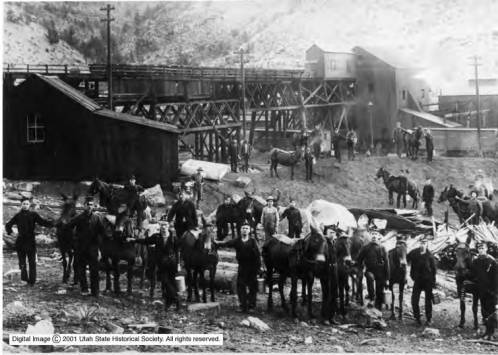Dublin Core
Title
Description
Welsh immigrants brought with them valuable skills that laid the foundation for Utah’s early mining industry.
Like other countries in Europe during the 19th Century, Wales felt the effects of the Industrial Revolution. Rapid increases in population and harsh working conditions in manufacturing and coal mining led to worker riots and clashes with factory and mine owners. The first Mormon missionaries arrived in Wales in 1840 and had great success in cities dealing with poverty and social conflict. But for many of the Welsh converts, the promise of a new life in America was not always realized.
Once settled in Utah, these Welsh immigrants sought to improve their circumstances, yet found their old lives were hard to leave behind. Their specialized coal mining skills were naturally sought after by Mormon leaders setting up industries in an effort to create a self-sufficient economy.
In 1854 two Welsh miners, John Price and John Reese, were assigned to tap a source of coal located at the foot of the Sanpitch Mountains in central Utah. Nearby the new mine they established a town called Coalbed, which they later renamed Wales in honor of their homeland. The community was populated solely by immigrants from the British Isles, a little bit of home transplanted to Utah.
When a disastrous accident in the Cymmer Mine back home in Wales claimed 114 lives in 1856, the Welsh miners in Utah were no doubt reminded that the harsh and dangerous working conditions they had fled could someday become a reality in Utah. In peak years, the mines near the town of Wales employed 200 men before giving way to larger, more profitable mines in nearby Carbon County. Those, too, drew many Welshmen and their skills. In 1900, when Carbon County’s Scofield Mine Disaster claimed more than 200 lives – many of them Welsh – those earlier fears of recreating dangerous working conditions were sorely realized.
Like many immigrants, Welsh settlers in Utah duplicated to some degree the lives they had tried to leave behind.
Creator
Michelle Hill for Utah Humanities © 2015
Source
Image: Castle Gate, Utah Mining. 1920. English and Welsh miners at Castle Gate. At right foreground, man holding a white bucket and standing next to a horse is Alma Hardee, killed in the 1924 Castle Gate mining explosion. Courtesy of Utah State Historical Society.
_______________
See Albert C.T. Antrei and Allen D. Roberts, A History of Sanpete County (Salt Lake City, Utah: Utah State Historical Society, 1999), pp. 135-139, 412-416; Frederick S. Buchanan, “Imperial Zion: The British Occupation of Utah,” in Papanikolas, Helen Z., The Peoples of Utah (Salt Lake City, Utah: Utah State Historical Society, 1976), pp. 61-113; F. James Bingley, Jr., Becoming American: the Welsh Mormon Journey, Ph.D. thesis, University of Houston, 2010; Erin Ann Thomas, Coal in Our Veins: A Personal Journey (Logan, Utah: Utah State University Press, 2012); “One Hundred and Ten Persons Killed by a Colliery Explosion,” Deseret News, October 29, 1856 (the final death toll was 114).
Publisher
The Beehive Archive is a production of Utah Humanities. Find sources and the whole collection of past episodes at www.utahhumanities.org
Date
2015-01-30

